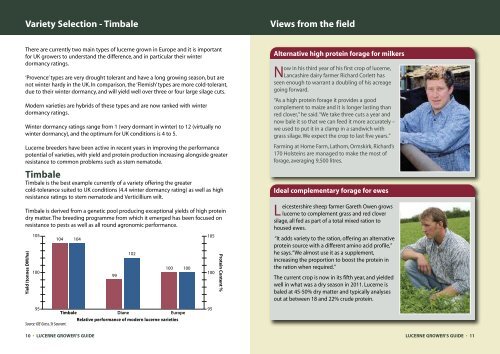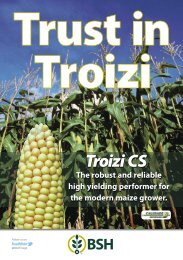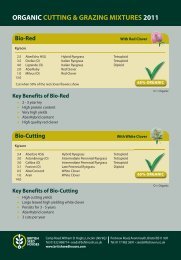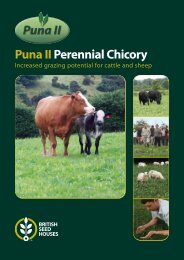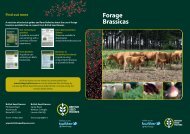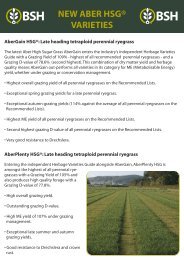Lucerne Growers Guide - British Seed Houses
Lucerne Growers Guide - British Seed Houses
Lucerne Growers Guide - British Seed Houses
- No tags were found...
You also want an ePaper? Increase the reach of your titles
YUMPU automatically turns print PDFs into web optimized ePapers that Google loves.
Variety Selection - TimbaleViews from the fieldThere are currently two main types of lucerne grown in Europe and it is importantfor UK growers to understand the difference, and in particular their winterdormancy ratings.‘Provence’ types are very drought tolerant and have a long growing season, but arenot winter hardy in the UK. In comparison, the ‘Flemish’ types are more cold-tolerant,due to their winter dormancy, and will yield well over three or four large silage cuts.Modern varieties are hybrids of these types and are now ranked with winterdormancy ratings.Winter dormancy ratings range from 1 (very dormant in winter) to 12 (virtually nowinter dormancy), and the optimum for UK conditions is 4 to 5.<strong>Lucerne</strong> breeders have been active in recent years in improving the performancepotential of varieties, with yield and protein production increasing alongside greaterresistance to common problems such as stem nematode.TimbaleTimbale is the best example currently of a variety offering the greatercold-tolerance suited to UK conditions (4.4 winter dormancy rating) as well as highresistance ratings to stem nematode and Verticillium wilt.Timbale is derived from a genetic pool producing exceptional yields of high proteindry matter. The breeding programme from which it emerged has been focused onresistance to pests as well as all round agronomic performance.Yield (tonnes DM/ha)105100104 10499102100 100105100Protein Content %Alternative high protein forage for milkersNow in his third year of his first crop of lucerne,Lancashire dairy farmer Richard Corlett hasseen enough to warrant a doubling of his acreagegoing forward.“As a high protein forage it provides a goodcomplement to maize and it is longer lasting thanred clover,” he said. “We take three cuts a year andnow bale it so that we can feed it more accurately –we used to put it in a clamp in a sandwich withgrass silage. We expect the crop to last five years.”Farming at Home Farm, Lathom, Ormskirk, Richard’s170 Holsteins are managed to make the most offorage, averaging 9,500 litres.Ideal complementary forage for ewesLeicestershire sheep farmer Gareth Owen growslucerne to complement grass and red cloversilage, all fed as part of a total mixed ration tohoused ewes.“It adds variety to the ration, offering an alternativeprotein source with a different amino acid profile,”he says. “We almost use it as a supplement,increasing the proportion to boost the protein inthe ration when required.”The current crop is now in its fifth year, and yieldedwell in what was a dry season in 2011. <strong>Lucerne</strong> isbaled at 45-50% dry matter and typically analysesout at between 18 and 22% crude protein.95TimbaleDianeEuropeRelative performance of modern lucerne varietiesSource: GIE Grass, St Sauvant.9510 • LUCERNE GROWER’S GUIDELUCERNE GROWER’S GUIDE • 11


